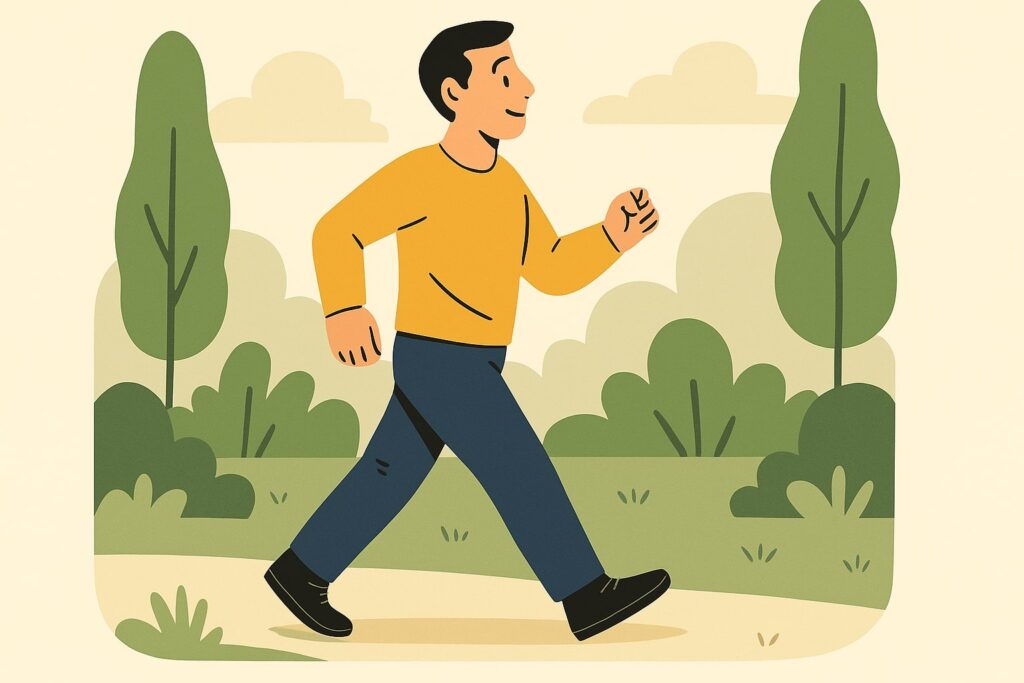Cardiovascular disease (CVD) is the leading cause of death globally, responsible for 17.9 million annual deaths in 2019, whereas cancers were responsible for 9.6 million deaths in 2017 as per WHO

Engaging in more intense or frequent physical activity, such as exercising for longer durations, participating in high-intensity workouts, or engaging in multiple physical activities throughout the day, is less likely to cause death from various factors such as diseases, accidents, or other causes. There is also a reduced likelihood of experiencing conditions such as heart disease, heart attacks, or strokes. In addition to reducing the risk of cardiovascular diseases, higher levels of physical activity are also linked to a decreased risk of developing certain types of cancers that occur in specific organs or tissues of the body.
Walking, which requires no equipment or a structured environment, is an incredibly simple and effective way to improve your overall health, but did you know that it could also be the key to preventing stroke and early death? In today’s fast-paced world, we often neglect the simplest of tasks, such as walking, but it has many benefits for our physical and mental health.
Medical research has found that walking can help reduce the risk of stroke and early death by up to 50%. It is a low-impact, easy-to-do exercise that can be done anywhere. Whether walking to work, around your neighbourhood, or to the local grocery store, this simple exercise can significantly impact your health. In this post, we’ll explore why walking is so beneficial, how it can help prevent stroke and early death, and provide tips on incorporating walking into your daily routine.
1. The importance of physical activity in a healthy lifestyle
Physical activity is an essential aspect of a healthy lifestyle. Calories burned = weight maintained or lost. Not only does it help maintain a healthy weight, but it also helps reduce the risk of various health conditions, such as heart disease, diabetes, and stroke. Studies have shown that physical activity can reduce the risk of stroke by up to 27 per cent. Increasing the duration or distance you walk daily may reduce your risk even further.
Walking is an excellent form of physical activity that can easily be incorporated into daily life. It’s low-impact and doesn’t require any special equipment or training. Just 30 minutes of walking daily can improve cardiovascular health, strengthen bones and muscles, and help maintain a healthy weight.
Aside from the physical benefits, walking is also beneficial for mental health. It’s a great way to clear the mind, reduce stress, and improve mood. It can also be a social activity with friends or family members.
Incorporating physical activity into a daily routine doesn’t have to be difficult, and walking is a great place to start. Whether taking a walk in the park, walking to work or school, or taking a stroll around the neighbourhood after dinner, every step counts towards a healthier lifestyle.
2. The link between walking and stroke prevention
Walking is a great way to improve your health, and recent studies have shown a strong link between regular walking and stroke prevention. Stroke is a dire medical emergency that occurs when blood flow to the brain is interrupted, and it can cause long-term disability or even death. However, research has shown that walking for just 30 minutes a day can significantly reduce the risk of stroke and other cardiovascular diseases.
One of the ways walking is thought to help prevent stroke is by lowering blood pressure. High blood pressure is a significant risk factor for stroke, and regular walking has been shown to help reduce blood pressure in people with hypertension. Walking can also improve circulation and help lower cholesterol levels, which is essential for maintaining a healthy heart and preventing stroke.
Another benefit of walking is that it can help reduce stress and anxiety, which can be significant contributors to stroke risk. Stress can cause a range of physical and mental health problems, and it has been linked to an increased risk of stroke. Walking is a great way to clear your mind and reduce stress, which can help to reduce your risk of stroke and other health problems.
Overall, walking is a simple but effective way to improve your health and reduce your risk of stroke and other cardiovascular diseases. Whether you prefer to walk outside in nature, on a treadmill at the gym, or simply around your neighbourhood, making walking a regular part of your routine can offer numerous health benefits and help you to live a longer and healthier life.
3. The link between walking and early death prevention
Many studies have shown that walking is one of the easiest and most effective forms of exercise. But did you know that walking could also be the key to preventing early death? There have been numerous studies linking walking to a reduction in early mortality. One study conducted by the American Cancer Society found that walking for just 2.5 hours a week could reduce the risk of premature death by up to 20%. Another study found that those who walked for at least 30 minutes daily had a lower risk of death from all causes.
This may be because walking has been shown to have a positive impact on many of the risk factors associated with early death, including high blood pressure, high cholesterol, and obesity. Walking also helps to improve overall cardiovascular health, which is a critical factor in reducing the risk of stroke and heart disease. So, if you are looking for a simple way to improve your health and reduce your risk of early death, why not try incorporating more walking into your daily routine? Whether taking a stroll during your lunch break or going for a brisk walk after dinner, every step could help improve your health and prevent premature death.
4. How much walking is required for maximum health benefits?
Walking is a great way to improve your overall health and well-being, but how much should you be doing for maximum health benefits? The answer is that it depends on your goals and current fitness level. For most people, the American Heart Association recommends at least 150 minutes of moderate-intensity aerobic activity per week, such as brisk walking. This can be broken down into 30 minutes a day, five days a week. However, if you want to lose weight or improve cardiovascular health, you should increase this amount.
For those new to exercise, starting slowly and gradually building up your endurance is essential. Walking for 10-15 minutes daily, three times a week, is a great starting point. From there, you can gradually increase the duration and intensity of your walks as your fitness level improves. It’s also important to remember that any amount of walking is better than none. Even small amounts of physical activity can help reduce your risk of stroke and early death. So, whether you’re taking a stroll through the park or walking to work instead of driving, every step counts towards a healthier you.
5. How walking can lower blood pressure and reduce stress
Walking is a simple and accessible exercise that can significantly impact our health. One of the benefits of walking is that it can help lower blood pressure, which is a critical factor in preventing stroke and heart disease. When we walk, our heart pumps faster, which helps to improve blood flow and reduce the workload on our heart. Over time, this can lead to a lower resting heart rate and lower blood pressure levels. Another way that walking can benefit our health is by reducing stress.
Stress can have a damaging effect on our bodies, leading to a range of health problems, including high blood pressure, heart disease, and stroke. Walking can help reduce stress levels by increasing the production of endorphins, our body’s natural feel-good chemicals. When we walk, we also have the opportunity to clear our minds and focus on the present moment, which can help alleviate stress and anxiety.
In addition to these specific health benefits, walking is also a great way to improve overall fitness and mobility. It’s a low-impact form of exercise that can be done at any time of the day and doesn’t require any special equipment or training. Whether taking a stroll around the block or going for a brisk walk in the park, walking is a simple and effective way to improve your health and reduce your risk of stroke and early death.
6. Other health benefits of walking
Walking is a simple and easy way to improve overall health and well-being. Beyond reducing the risk of stroke and early death, there are many other health benefits of walking that you can enjoy.
Firstly, walking is a low-impact exercise that can help you maintain a healthy weight. Combined with a balanced diet, regular walking can help burn calories and keep a healthy body mass index (BMI). This can also help reduce the risk of other chronic conditions such as heart disease, Type 2 diabetes, and certain types of cancer.
Secondly, walking is excellent for your mental health. It can help reduce stress and anxiety, boost mood, and improve overall well-being. Walking outdoors can be particularly beneficial, as it allows you to connect with the natural world and enjoy fresh air and sunshine.
Lastly, walking can also improve your cardiovascular health. Taking a short stroll after eating might assist with bringing down your glucose levels. Strolling can safeguard the knee joint by expanding synovial fluid. Walking at a moderate speed for 30 to 45 minutes daily lessens days off by 43% and, by and large, brings down the upper respiratory plot contaminations. It builds your energy levels since it increments oxygen moving through your body, which can expand cortisol, epinephrine, and norepinephrine levels.
As to psychological wellness, strolling can assist with lessening nervousness, sorrow, and a terrible state of mind. It can likewise increment confidence and ease sensations of confinement. Walking at a quicker speed might assist you with living longer. Scientists found that strolling at a typical speed, rather than a sluggish speed, brought about a 20% lower chance of, by and significant demise. Strolling can assist with reinforcing your leg muscles. You can remember slants for your strolls, like steps, strolling in an uneven region, or strolling on a graded treadmill inside.
It upgrades innovativeness. In a four-experiment study, scientists compared individuals attempting to concoct novel thoughts while strolling or sitting. The analysts found that members who decided to walk performed better, notably when they stepped outside. Strolling like this is a free progression of thoughts and is a primary method for helping innovativeness while getting some activity.
Walking is a simple and accessible way to improve your health and well-being. Whether walking to prevent stroke and early death or boost your physical and mental health, incorporating regular walks into your routine can benefit you.
7. Ways to incorporate more walking into your daily routine
Incorporating more walking into your daily routine is easier than it may seem. Here are a few ways to get started:
a) Take the stairs instead of the elevator: This is one of the easiest ways to add more walking into your routine. Climbing the stairs is a great way to increase your heart rate and burn calories.
b) Schedule walking meetings: Instead of sitting in a conference room for a meeting, suggest a walking meeting. Not only will you get some exercise, but studies have shown that walking can also help improve creativity and focus.
c) Park farther away: Instead of circling the parking lot looking for a spot closest to the door, park farther away and get some extra steps in. This is especially easy when running errands or going to the grocery store.
d) Take a walk after meals: A short walk can help improve digestion and regulate blood sugar levels. Plus, it’s a great way to get fresh air and clear your mind.
e) Use a pedometer or fitness tracker: If you’re having trouble staying motivated, using a pedometer or fitness tracker can help you track your progress and set goals for yourself. Many smartphones also have built-in step counters that you can use to track your daily activity levels.
Incorporating more walking into your daily routine doesn’t have to be a chore. Making small changes to your daily habits can improve your health and reduce your risk of stroke and other health problems.
8. Tips for staying motivated to walk regularly
Walking is a simple and effective way to improve your health and reduce the risk of stroke and early death. However, staying motivated to walk regularly can be challenging, especially for those with busy schedules or who struggle to find time for exercise. Here are some tips to help you stay motivated to walk regularly:
a) Set achievable goals: Start with small, achievable goals and gradually increase the duration and intensity of your walks. This will help you build endurance and avoid burnout.
b) Mix it up: Walking the same route daily can get boring. Mix up your walking routine by exploring new neighbourhoods or parks, listening to music or podcasts, or walking with a friend or pet.
c) Schedule it. Make walking a part of your daily routine by scheduling it into your calendar. This will help you prioritize exercise and make it a habit.
d) Use technology: Some apps and devices can help you track your steps, distance, and progress. Using these tools can help you stay motivated and accountable.
e) Join a walking group: Joining a walking group or club can provide social support and accountability and opportunities to meet new people and explore new places.
Remember, walking doesn’t have to be a chore. The right mindset and approach can be a fun way to improve your health and quality of life.
9. How to make walking a social activity
Walking is a great way to stay healthy and prevent stroke and early death. However, it can become dull and repetitive if you continuously walk alone. Making walking a social activity can help you stay motivated and enjoy the experience more. Here are some tips on how to make walking a social activity.
Firstly, you can join a walking group or club in your area. These groups are usually formed of people who enjoy walking and like to do it in a social setting. You can find walking groups through social media, community centres, or even your local gym. This is a great way to meet new people and enjoy walking together.
Secondly, you can organize walking events with your friends and family. You can plan a weekend walk in the park, a hike in the mountains, or even a walking tour of your city. This is a great way to spend quality time with your loved ones and stay active at the same time.
Thirdly, you can use technology to connect with other walking enthusiasts. Many walking apps allow you to join virtual walking groups, track your progress, and even compete with other users. This can be a fun and interactive way to make walking a social activity.
In conclusion, walking doesn’t have to be a solitary activity. By making it a social activity, you can stay motivated, meet new people and enjoy the experience more. So, grab your walking shoes and start exploring the world around you!
10. Incorporating mindfulness into your walking routine.
Walking is a great way to keep your body healthy and combat the risk of stroke and early death. But what if we told you you could take your walking routine to the next level by incorporating mindfulness? The benefits of mindfulness are well documented, and studies have shown that it can help reduce stress levels, improve focus, and enhance overall well-being.
So, how can you incorporate mindfulness into your walking routine? Firstly, take the time to tune into your surroundings. Rather than simply pounding the pavement or staring at your phone, use your senses to take in your environment’s sights, sounds, and smells. Focus on breathing, taking deep, slow breaths as you walk, and being present.
You could also incorporate a walking meditation into your routine. This involves walking slowly and steadily and focusing your attention on your breath or a mantra. As thoughts or distractions come up, acknowledge them and then bring your focus back to your breath or mantra. This technique can be incredibly calming and help reduce stress levels.
Incorporating mindfulness into your walking routine is a simple yet effective way to enhance the benefits of walking and keep your mind and body healthy. Try it out for yourself and see the difference it can make.
Walking is a great exercise perfect for people of all ages, regardless of fitness level. Walking is one exercise that can be done anytime, anywhere, because there’s no need for fancy equipment or gadgets. You should be all set as long as you have feet and shoes and can walk upright. As an exercise, walking has numerous health benefits, including preventing certain diseases and the promise of longevity.
We hope this article gave you a better understanding of the many benefits that walking can have on your health, specifically in preventing strokes and early death. Walking is a simple, low-impact exercise that can be easily incorporated into your daily routine, and the health benefits are undeniable. By walking regularly, you can improve your cardiovascular health, reduce your risk of stroke, and increase your longevity. So, put on your walking shoes and step towards a healthier you!
Disclaimer: The views and opinions expressed in this article are the personal opinions of the author.




hi!,I like your writing very a lot! percentage we communicate more approximately your post on AOL? I need an expert in this space to solve my problem. Maybe that is you! Having a look forward to peer you.
Hello to every body, it’s my first pay a visit of this website; this weblog consists of amazing and truly good material for visitors.
Thanks for your marvelous posting! I really enjoyed reading it, you may be a great author.
I will remember to bookmark your blog and definitely will come back
sometime soon. I want to encourage you continue
your great job, have a nice day!
I have been exploring for a little bit for any high quality articles or blog posts on this kind of area . Exploring in Yahoo I at last stumbled upon this website. Reading this information So i抦 happy to convey that I have a very good uncanny feeling I discovered exactly what I needed. I most certainly will make certain to don抰 forget this web site and give it a look regularly.
Nearly all of the things you state happens to be supprisingly precise and it makes me ponder why I had not looked at this in this light before. This particular article truly did turn the light on for me personally as far as this specific issue goes. However there is actually just one point I am not really too comfy with so whilst I make an effort to reconcile that with the central idea of your position, permit me see just what the rest of your readers have to say.Very well done.
When I initially commented, I clicked the “Notify me when new comments are added” checkbox and now each time a comment is added I get several emails with the same comment. Is there any way you can remove people from that service? Thanks.
There’s noticeably a bundle to learn about this. I assume you made certain good factors in options also.
Terrific post but I was wondering if you could write a litte more on this subject? I’d be very grateful if you could elaborate a little bit more. Thanks!
Hello. And Bye.
You made some nice points there. I did a search on the subject and found most guys will agree with your website.
It’s perfect time to make some plans for the future and it’s time to be happy. I have read this put up and if I may just I wish to suggest you few attention-grabbing issues or suggestions. Perhaps you can write next articles regarding this article. I desire to read more things about it!
Hello just wanted to give you a quick heads up. The words in your post seem to be running off the screen in Ie. I’m not sure if this is a formatting issue or something to do with browser compatibility but I thought I’d post to let you know. The layout look great though! Hope you get the problem fixed soon. Many thanks
I’d like to find out more? I’d love to find out more details.
I’m so in love with this. You did a great job!!
Use Self-Hypnosis to Restore Your Nervous System and Unlock Inner Peace
self-hypnosis techniques [url=https://www.youtu.be/i3pdwnkjwng/]wellness practices[/url].